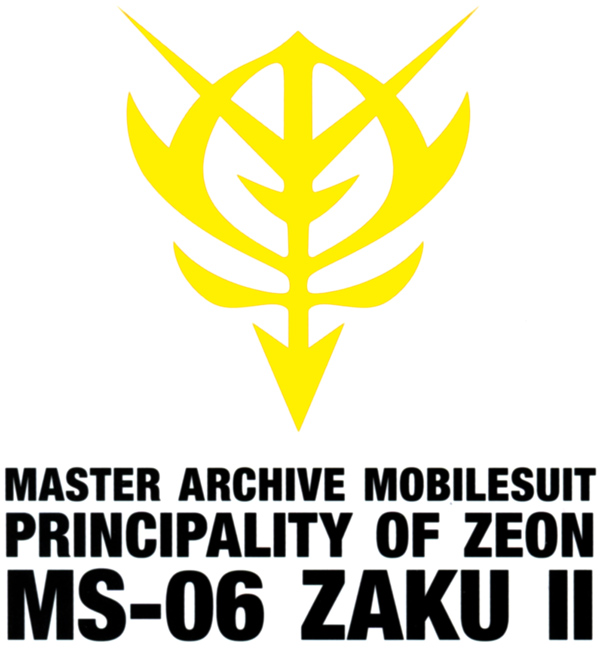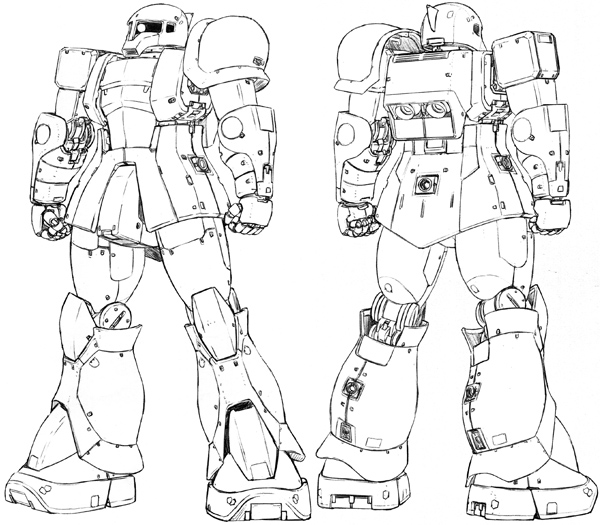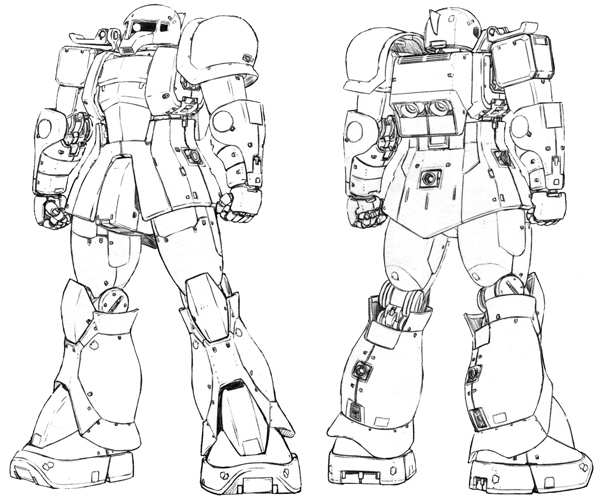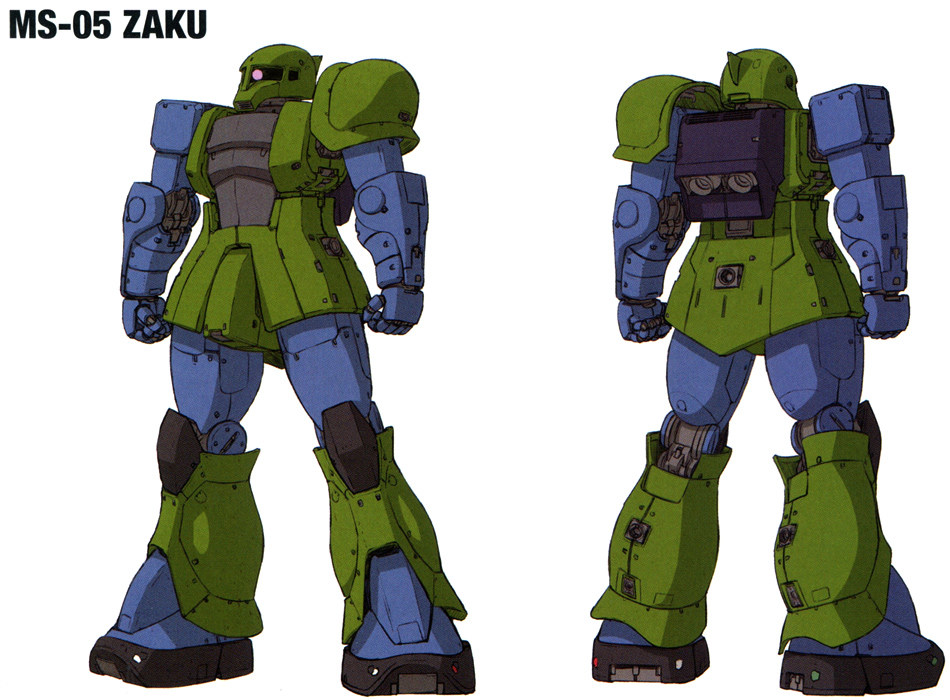
It is a well-known fact that in the early stages of the Zeon war for independence, later known as the “One Year War,” the Principality of Zeon with their inferior national strength, overwhelmed the Earth Federation Forces, which boasted an exceptionally strong fleet fighting force. Their behind the scenes dominance in combat came from the existence of a new weapon called a mobile suit (hereafter MS). At the outbreak of the war in particular, the MS-06 Zaku II formed the main forces of the Principality Forces and in addition to their function on the battlefield, it had tremendous influence on mobile suit development of both sides forces, while creating a vast variety of family suits, not to mention certifying its position as a “masterpiece.” As a first step in deepening the understanding of the MS-06, the text herein will try to explain the “standard machine” that laid the foundation of a family of suits as well as mainly on the modified units such as the recon type and high mobility type.
![]()
CONTENTS
MS Photo Files
PRODUCTION & DEVELOPMENT OF THE MS-06 ZAKU II SERIES
MS-06A ZAKU II
MS-06C ZAKU II
MS-06F ZAKU II
MS-06S ZAKU II
MS-06E ZAKU RECON
MS-06E ZAKU FLIPPER
MS-06RP ZAKU II
MS-06R-1 ZAKU II
MS-06R-1A ZAKU II
MS-06R-2P ZAKU II
MS-06R-2 ZAKU II
MS-06R-3/R-3S ZAKU II R3S
BACKGROUND OF THE TECHNOLOGICAL BASES OF MOBILE SUIT DEVELOPMENT
STRUCTURE AND SYSTEM OF THE MS-06
ARMAMENTS
![]()

■モビルスーツの誕生
THE BIRTH OF MOBILE SUITS
In U.C.0069, a lone particle is discovered on “Munzo” of Side 3, a cluster of colonies furthest from the Earth. The “Minovsky Particle,” named after Dr. Trenov Y. Minovsky the leader of the research group who discovered it, would later have immeasurable influence on history. In March of U.C.0070, the Minovsky particle was confirmed to have special characteristics such as the disruption of radio waves as demonstrated by the Principality of Zeon forces in an experiment.
At that time, Side 3 continued on their fast-track of independent lines from the Earth Federation following their declaration of the Principality of Zeon on August 15th U.C.0069. Of course, the Earth Federation refused to acknowledge this and increased pressure both politically and economically, and at the time the executives of the Principality had begun to seriously consider “military options” as a means to achieve true independence. Under these circumstances, these new particles that were discovered could paralyze radar as well as various guided weaponry. It could be said that it was natural that the Principality of Zeon gained momentum, having found a means to shutout electronic warfare that the Federation Forces was considerably skilled at. The Zeon’s defense ministry immediately initiated the development of mobile weapons for visual combat under the premise of operating on a battlefield with nullified radar due to “aggressive Minovsky particle dispersal tactics.” Thus, in U.C.0071, a number of domestic weapon manufacturers would be issued a notice requesting participation in a new weapons development competition.
In response to this, Zeonic, a leading Side 3 weapons manufacturer, formed a special project team within their company to face what would become an extremely fierce development competition. The engineers who gathered for this project designated it S.U.I.T. (Space Utility Instruments Tactical) and was said to have had repeated thorough discussions where they conducted a careful examination of the new weapons suggested by the defense ministry. As a result, the answer they arrived at was an eccentric idea of a “humanoid mobile weapon with two pairs of AMBAC-extremities that imitate limbs.” AMBAC refers to Active Mass Balance Auto Control and is a technology considered to be effective in reducing propellant consumption. While adopting it isn’t extraordinary in itself, attempting to fashion AMBAC extremities that resemble humanoid arms and legs is said to be an absurdity that surpasses innovation. Nonetheless, these new weapons would possess a surprising degree of versatility, adding a revolutionary idea to allow for various functions: as a platform with arms capable of changing armaments according to the strategy and legs utilized for travel under gravity.
After about two years of research, the SUIT Project rolled out their experimental unit, the ZI-XA3 Crabman. Even though a control mechanism hadn’t yet been built into the machine and the power was dependent on external sources, the ZI-XA3 satisfied the performance requirements as directed by the arms procurement committee of the defense ministry and it moved on to take part in a selection test conducted in October U.C.0073. This time, it was only MIP’s MIP-X1 that competed against the ZI-XA3 for adoption which clearly illustrated how difficult it was to satisfy the defense ministry’s proposed conditions.
As one former defense ministry staffer recalls, on the day of the test, when the ZI-XA3 made its appearance at the secret testing grounds, it was as though a gigantic humanoid robot had jumped out of a sci-fi movie with its 14m height and 17t base weight and it is said to have caused mixture of derisive laughter from half of the military high officials who came to observe it. However, the results from the testing carried out at maneuvering grounds on the lunar surface, the asteroid belt and inside colonies were dotted with numerical values indicating the superiority of the Crabman that was derided as a “giant wearing a spacesuit.” Although the MIP-X1 was slightly superior in mobility under gravity, the ZI-XA3 exceeded all other categories. Thus, the defense ministry formally ordered the development of a new type of mobile weapon from Zeonic and following their decision to designate them “mobile suits,” they elected to give the model number “MS-01” to the ZI-XA3. However, being watched by Earth Federation Forces, it was thoroughly camouflaged and carried out under the pretext of “development of manufacturing worker units” when appropriating such an enormous development budget. Furthermore, although a digression, while the MIP-X1 lost in the competition, as a result of of being deemed a future prospect, they would receive a separate go-ahead for continuing development. They would later create mobile weapons known as “mobile armors,” but that is another story.
■実戦型MSに至る道筋
THE PATH TO COMBAT-TYPE MOBILE SUITS
The SUIT Project accelerated as a result of its extensive budget from its victory in the selection test. The MS-02 became the test unit following the ZI-XA3/MS-01 Crabman, succeeding in incorporating a control mechanism. Although its power still relied on a supply source outside the body, there was certain progress such as improving mobility, which was regarded as a fault in comparison to the MIP-X1. The MS-03 which was developed following this installed a power source inside the machine and saw independent movement in a short period of time. The development program progressed steadily.
However, the project team now faced a giant hurdle. In order to give the machine the strength it required as a weapon, the effects of applying armor to the MS-03 based on the assumption of combat pushed the base weight to 28 tons and the mobility that was supposed to have improved had decreased to about 60% in comparison to the MS-02. Upon receiving these unintentional results, the engineers suspended work on MS-03 Prototype Unit 3 that was undergoing construction and would make drastic design changes in order to achieve substantial weight reduction.
Among the changes, the biggest decision would be the adoption of a frameless monocoque system. However, while this design change started off prepared to re-evaluate the structure of the machine from the ground up, it was never realized and it seems that the situation even continued to fall far short of in-house target values. The development of the MS-03 had finally reached a tragic deadlock.
There was a glimmer of hope for a project that had such dark clouds hanging over it. It came from an unexpected direction. ZAS, a Side 3 engine manufacturer, was successful in implementing an innovative miniature thermonuclear reactor that applies Minovsky physics. This Minovsky-Ionesco-type thermonuclear reactor called the ZAS-X7 was superior in that it was about 20% lighter and the output was double of the main unit installed in the MS-03. Having acquired the ZAS-X7 that possessed all factors required: miniature, light weight, high-output, the SUIT Project set out to develop the MS-04, a new prototype model.
■MS-05〈ザク〉の量産
MASS PRODUCTION OF THE MS-05 ZAKU
<<TEXT HERE>>

MODEL NUMBER: MS-05A (YMS-05)
HEAD HEIGHT: 17.5m
BASE WEIGHT: unknown
ARMOR MATERIAL: super-hard steel alloy
GENERATOR OUTPUT: unknown
THRUSTER PROPULSION: unknown
■MS-05<ザク>先行生産機
MS-05 ZAKU EARLY PRODUCTION UNIT
The MS-05A was the first production unit of the MS-05 implemented as a combat-use unit. With its position as an early production model, it is said to be a mass produced unit which identifies troubles on the production line. The number of units produced is considered to be 27, but its actual total production run is 32 units. Thirty units were supplied to the military: 27 of which were units for the mobile training battalion with 3 as spare machines. Two units were left at the testing facilities for manufacturer tests. In addition, it is said that parts that could complete ten units if assembled were delivered to the military as expendable supplies (running stores). Of these, three suits were quickly assembled into fully operational status as a teaching tool by the military maintenance unit. Of course, the replacement parts of the running stores were sent separately to the maintenance units.
* The construction numbers are 0501-00001 to -00032, 00033P to -00042P. The P on the end represents unassembled. The ones that were placed at Zeonic’s testing facilities are 0501-00001 to -00002.

MODEL NUMBER: MS-05B
HEAD HEIGHT: 17.5m
BASE WEIGHT: 50.3t
FULL WEIGHT: 65.0t
ARMOR MATERIAL: super-hard steel alloy
GENERATOR OUTPUT: 899kW
THRUSTER PROPULSION: 40,700kg
■ MS-05B
A full-scale mass production unit whose ZAS manufactured powerplant was replaced with the Y&M manufactured one. The MS-05A (0501-0001 and 0501-0002) were used as the test bed. Production lines were established outside of Zeonic’s main factory and production began at all 11 facilities across five colonies, including subcontracted assembly lines. Production started on the initial order of 100 units (c/n 0510-00001 to 00100), and of the first ten completed, two units (0510-00002, 0510-00010) were delivered early to the military. Two other units (0510-00001, 0510-00005) remained at the in-house testing facilities and the remaining six units were sent to the mobile training battalion to await instruction by the military. After that, assembly of the suits were carried out on the lines but an additional 200 units were ordered apart from that in addition to another 200? in three batches bringing the total order to 900 units. Among them, half of the 100 units in the final order was canceled on account of the prospects of producing the next mobile suit. The total number of units finally delivered to the military was 793 after allowing for those loaned out to firearms manufacturers and suits retained by manufacturers.





